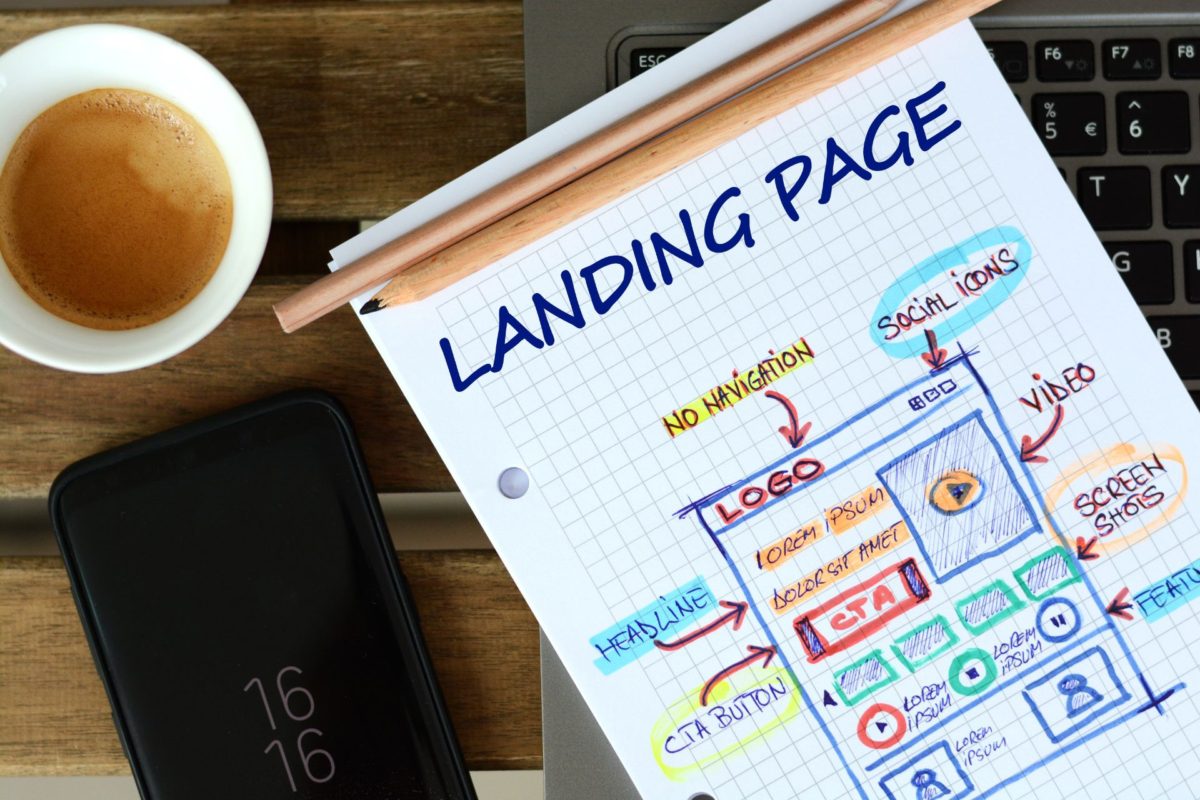This guide breaks down how to create a landing page that converts, guiding you through the process of selecting the right tools, crafting compelling content, designing with impact, and testing to ensure peak conversion rates.
Well-planned activities allow teams to complete many projects on time and with the expected results. It is the same when you design pages. Planning tasks is a solid groundwork that enables to create an exceptionally functional website. How to prepare an appropriate schedule for planning a website project? Where to start the design project? Whom to involve in the process? For top tips, check out this article!
Planning a website project – why is it important?
The appropriate website design project plan is the key to success when creating your website. The web design process is very complicated and usually involves a few, sometimes even a dozen, or so people. Therefore, the most important thing is to let everyone who is involved in the project know what and when to prepare. It is also worth mentioning the order of the actions. What happens if you choose to work without a project plan?
- The entire development team will have to work according to their own assumptions, which will not only cause communication chaos and frustration, but also significantly extend the project.
- You will be frequently returning to the design project or its functionality, as well as making notorious corrections, doing the same things twice, and rethinking the chosen solutions.
- You will face an uncontrolled scope creep that will extend and break your work.
- You will miss the deadline for your website, which will result in customer dissatisfaction or your team’s frustration. Web design is often initiated by a marketing department that needs a website to carry out certain activities. If the development team fails in delivering the project on time, the marketing team will not be able to go live.
- The created website will not meet the expectations and will have to be developed once again.
As you can see, when you decide to skip planning a website project, most probably you will face negative effects on the final design of your website and your collaboration with your client. That is why it is worth spending some time on it. Everyone who has managed to create websites will confirm this!
A website project plan – how to start?
Now that you know that planning web design is a good idea, it is time to get ready. You need to establish some of the most important elements that will make the project planning and work go smoothly.
Step 1. Choose a project manager
Project managers are people who assemble and manage the website development team. The person you select for this role will be responsible for the research, planning process, implementation, and communication. Ultimately, this employee will also actively participate in creating the functional specification document, collect the website’s documentation, accept the created product, keep the schedule and take the consequences for people who do not stick to the deadlines.
Moreover, it is the project manager who will work closely with both the client and the entire team. That is why you need to choose a relevant team member who is responsible and can manage people. But that is not all! The selected person must also have project management skills, that is, be proficient in planning work and dividing it into thematic blocks, as well as making sure that everything goes according to the assumed project plan. The ability to work under time pressure will also come in handy.
Of course, if you are a business owner and want to be a project manager yourself, there is nothing to stop you. Just remember that such activities require enormous commitment, which usually entrepreneurs cannot afford.

Step 2. Select team members
Project managers are most likely to hire people who will contribute to the website project. The team member who must be on each web design team is:
- A developer who will be responsible for creating a website development from scratch. No web development projects can succeed without someone in this role.
- An analyst who will do the initial research to check the competitor sites on the market and propose appropriate solutions.
- A graphic designer who will prepare all graphic elements, e.g., page layouts, infographics for the contact page, icons, etc., as well as the overall website design.
- A content manager who will list what content should appear in specific places on the site.
- A copywriter who will create the content.
- A QA tester who will check all functionalities and the design project.
You should also be in touch with a lawyer and photographer, as they can be of use in the web design process. Why? Perhaps you will need a professional photo session for the “About us” page or you will simply need product photos for the store. A good photographer will turn out to be worth their weight in gold! A lawyer, on the other hand, is a must-have when you create regulations and privacy policy! In fact, the website design projects involve multidisciplinary teams with skills that will help them build a unique website. Remember that this cannot be done without an effective manager who is excellent at project management and website development in every aspect.
As you evaluate the expertise and skillsets of potential team members, it’s also essential to consider the complementary expertise that a web design agency can bring to your project. We’ve covered this aspect in our article on “How to Choose a Web Design Agency“.
Step 3. Decide on a project management methodology
It is usually the project manager who decides what working methods should be used and determines which option will work best for a given team. These are the most frequently chosen approaches to web design:
- Agile – in this system, it is assumed that teams are self-organizing and cross-functional. The project manager therefore divides the web development team into smaller groups. Each unit creates a project definition and decides on the process and tasks. It is important that their members have all the competencies and skills necessary to complete the specific issues. In addition, this method puts a lot of emphasis on change, which is considered a frequent element of every part of the project.
- Waterfalls (or the cascade model) – is a system in which each stage has to be completed in order to start working on the next one. Before the previous phase does not undergo tests, the workflow stops. However, changes can be made at every stage. There is a strict hierarchy of the team, where the elected manager is responsible for the overall project management.
- Kanban – in this system, work is divided into specific sequenced tasks and steps. Team members take care of their part of the project and then pass the product on to the next person, so they can complete the assigned activities. This method works similar to a production line. In this approach, the person responsible for project management can be compared to a shift supervisor.
Choose a project management platform
It is difficult to manage website projects if you do not have the appropriate tools that will enable the project manager to allocate project tasks without any problems and in a way that is clear for everyone on the team. Additionally, the programs allow the manager to track progress and measure performance. Such project management platforms are, for example, Asana, Trello or Toggl.

Project management – a concept is the key
The process should start with a conceptual project plan. You need to think carefully or ask the client what the new website should look like, what functionalities it must have, as well as what the company’s core values are and how it stands out on the market. This will help you to define the project goals. In fact, each website is created for a different purpose, among many for sales, business presentation, or a blog with insights on particular subjects. The aim of the website significantly influences the website project. You can create the so-called mood board that allows you to collect all the ideas discovered in the brainstorming, and then organize them in the right way in the next stages of planning. Gathering comprehensive project requirements is essential, and it’s a topic we covered extensively in our article on website design request for proposal.
You should also find out what the website’s target audience is, as this will help you determine what elements will be useful. For example, in the case of online stores, it is necessary to enable customers to set up an account. In comparison, business web pages definitely do not require this feature. Additionally, it is important to establish the budget and the deadline. Remember that in proper project management, the ability to obtain key information from the client is essential.
Web design – choose the right CMS
At this stage, it is also worth choosing the CMS for the website. Among many, you can decide on the popular WordPress or the more advanced Joomla. The alternative is to have a custom management system created by programmers. It all depends on your preferences, needs, and required functionalities.
When choosing a CMS, you should think about the end-user who would manage the website. If they lack technical skills and never managed any web pages, it is better to decide on a simple, intuitive system, such as WordPress.
Website architecture – the important elements
After you initially determine the site’s concept, you need to focus on the website architecture. The website project plan should include:
- Home page content – you should focus primarily on the information you want to share at the beginning. This is where you present your brand, so it must be refined in every aspect, especially in terms of communication.
- Menu items – all the necessary subpages should be listed in the initial phase. Remember that the simpler and more intuitive the menu is, the better. The basic items that are usually found on most websites are About us, Offer, and Contact. Many companies also add a link to a Shop or Blog. All the pages, categories, and subpages should be properly described to make them as easy to access as possible.
- Additional elements – you do not need any special features on every page, but if you come up with anything that can influence your customers, it is worth using. It might be a pop-up with a subscription to the newsletter, a live chat with an advisor that will help clients choose the perfect offer, or maybe an option that allows them to type a number, so a consultant can call them immediately. However, keep in mind that not everything that is included in the website project plan may look great in reality, as there might be some limitations. Therefore, you should use only those functionalities that you can control and manage. User support systems are a wonderful option, but they do not work for every company. Why? If, for example, you do not have a delegated person that can reply in the chat, or you have significantly fewer consultants than requests, give it up. If a customer has to wait too long for service, they will get frustrated and leave.

Web design – what do you need to remember?
The next step of website planning should be concerned with the visual side of the website project. Even though it may seem not that important, visual identification and the entire website design project are one of those elements that can attract or push away potential customers. So bear in mind that the colors, fonts, icons, and layout styles you choose should be carefully considered.
It is worth asking the person responsible for the initial visual identification for a few examples from the industry, so you can choose the appropriate style for your website. At this stage, project management includes assigning tasks to the creative team who builds visual identity and website templates. Then you should plan and schedule work for the developers who will implement those elements on the website.
Our web design services are dedicated to creating unique and user-centric websites, connecting deeply with your intended audience and propelling the growth of your business.
Website content – delegate tasks when the website plan is being created
It goes without saying that the proper website project plan should include all content. Texts, product photos, additional photos, graphics, infographics, and regulations require the work of many people. This is why you need to plan and allocate project tasks in advance. Only then you can be sure that everything is under control when you implement the website project.
To facilitate the website content creation process, it’s essential to hire both a copywriter and content manager to collaborate on developing and organizing content for the site. It will also be necessary to cooperate with a photographer, who will take photos and prepare them for publication, as well as with a graphic designer who will provide visual project deliverables. You also may want to consider collaborating with a lawyer who will write legal documents, such as terms and conditions.
SEO – do you need to plan the optimization as early as the web development stage?
Content and SEO should be tackled in the same phase of development planning. It is best to work with SEO experts when preparing materials for the website. The professionals will prepare specific guidelines for key phrases and other necessary elements supporting search engine optimization. Of course, the project scope does not have to include SEO at this point. You can successfully implement these types of activities later, but in that case you need to be prepared to spend more time and money. Experts recommend introducing project plans so that you do not add more work after launching the website. It is also worth asking if the client team has in-house SEO specialists who want to take part in the process.

A domain and hosting – do not forget to buy them!
You need to remember that a domain and hosting are an essential part of web development. The website project plan should already include the date when you will obtain these two IT infrastructure elements that allow to place the website on the server later. Both project’s tasks, domain and hosting purchase, are key deliverables necessary for the website to function.
Website timeline – the basis for the effective project
In a website project plan, each stage should be broken down into smaller parts. All tasks, even the tiniest ones, should have end dates assigned to them. Each employee needs to be given a specific deadline and know who takes over after their part to ensure that the website project will move forward. Of course, the final delivery deadlines must be agreed with the team member who will perform the task who can estimate how much time it takes to complete it. You should also remember not to try speeding up the website development process because it may result in errors. For example, you may find mistakes or typos in the written sales content, or your team might only do quick and careless QA testing. In the project schedule, you need to include any important elements that may extend the completion date of the web design project. These are, for example, annual leaves of specific employees, as well as any public holidays that are days off. At the end of each timeline, there should be a launch date for the completed website.
Milestones – motivating elements of the schedule
It is also important to include milestones in the project schedule. When you establish the website project plan, you should not forget about this, as it gives you the opportunity to visualize what will happen next and allows the website development team to see the project’s progress.
How to present the project to the development team?
Creating a project plan and schedule is just as important as presenting it properly. If the people you work with do not understand the system in which the website project will be implemented, they will not be able to handle the program you are working in or, even worse, find their role in the entire development process. In such a situation, there is no chance for success. That is why it is a good idea to organize regular team meetings where you can address any doubts regarding your website project plan, answer questions and receive feedback from your colleagues.

Summary – how to prepare a good website project plan?
An appropriate project plan contributes to effective website development. To create it, you need to:
- Build a project team led by a qualified project manager.
- Select the methodology of the website project.
- Decide on the tool that allows you to separate tasks and monitor their performance.
- Carefully analyze the needs of the website and plan its concept.
- Choose the right CMS for web development.
- Plan website architecture.
- Create the visual identity of the website and plan everything related to the visual layer of the website project.
- Prepare a detailed project plan for the website content (texts, graphics, etc.) and delegate tasks to appropriate people.
- Plan your SEO activities if you want your web design project to be optimized from the beginning.
- Buy a domain and hosting, as no web design projects can be launched without them.
- Create a clear timeline for the web design project.
- Present your website project plan to the entire team and make sure everyone understands it.
Now you know all about the technical aspects of web design projects. We hope this will help you in your online activities! If you want to learn more about web design, e.g., in house software development vs outsourcing differences or marketing integrations, visit our blog. There are many more industry insights waiting for you. For example, you can find out what RFP for software development is or discover what skills are required for website development. Keep in mind that you can entrust us with building your website, as we offer custom web development services, which we tailor to your needs!






